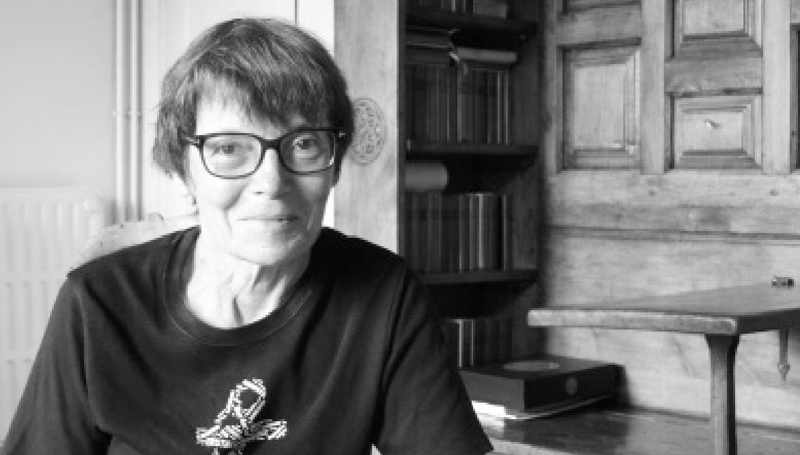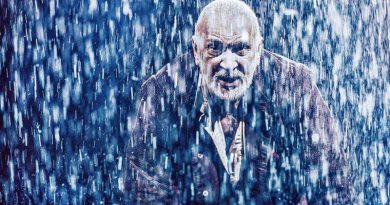Theatre photographer Laurencine Lot interviewed by Dana Rufolo
“The Actor Above All Else”
Like Johan Persson and Marc Brenner, Laurencine Lot is a name that has often appeared under photographs published by Plays International & Europe. Probably the best known theatre photographer in France today, Laurencine Lot treasures her relationship to the actors she has photographed and to the other people in the theatrical community that she knows and works with.
Interviewed in her home, Laurencine proudly showed me her own copies of her books of theatre photography, covered with dedications from the actors she has photographed with such sensitivity. Not only did they thank her for their expressive portraits but they made it clear that she was, to them, a dear friend. I was left with the feeling that those in France who have embraced the theatrical profession are a large and caring family. DR
It seems to me that your considerable reputation in France as a theatre photographer rests on the fact that you have an incredible ability to capture the sensuality of the actors when you photograph them during performance. All anyone needs to do is to look at your extraordinary book “Instants de théâtre” (Paris: Tohubohu Éditions, 2016) with the up-close and tender photos of such great actors as Catherine Samie, Michel Bouquet, Juliette Binoche, Antoine Vitez, Angélica Liddell, Éric Ruf, Maria Casarès, Carlotta Ikeda, Bakary Sangaré, Charles Berling and many more. The author of the 1995 “Dictionnaire encyclopédique du théâtre”, Michel Corvin (who wrote the accompanying texts) rightly claims that, as a photographer, you “abolish the distance” between you and your subject (“la photographie, elle, supprime les distances…”) in order to capture the “essence” of the theatrical moment.
Yes, I agree with you. “Instants de théâtre” came about because among my many photography exhibits all over the place, there was one running non-stop of portraits of actors, real portraits – 90 of them. Michel Corvin stepped in and afterwards he asked, ‘Laurencine, I’d like to make a book with you. And if we do make this book together, I’d like to make sure we introduce the actors’ hands”. My earlier books of theatre photographs, “Monstres sacrés, Sacrés Comédiens” [Waterloo, Belgium: Renaissance du livre, 2004] for instance, did not particularly focus on the actors’ gestures. In “Instants de théâtre”, you see lots of hands, [practically every photo includes hands caught in the midst of achieving a theatrical gesture]. Hands also speak. They are also expressive.

Catherine Smith in Les Femmes savantes.
Photo credit: Laurencine Lot.
I’m particularly interested in the intimacy of your approach because it differs from the British approach to theatre photography. I have the impression that space does not interest you, the stage space, because what you are doing is approaching the actor.
I try to plumb the depths of the actors.
Your approach isn’t geometric. You don’t concern yourself with the geometry of space.
No. I take photos of the stage decor to please the scene designers, but it isn’t fundamentally the stage set that interests me. I take these photos for the sake of keeping alive the memory of that particular production’s set design.
Yes, clearly it is the actors, alive on stage, living emotions during the play, that attracts you. And their sensuality. How have you developed your capacity to find the intimate physical presence, the intensity of contact when the actors are caught at a rapturous moment in role on stage? Do you select out this kind of photograph from the range of ones you take?
In effect, I take a lot fewer photos during a performance than is typical, but even so I’ve taken a lot more than the final selection of a couple dozen very good photos; it seems to me that 20 to 40 photos are enough to tell the story of any play. It wouldn’t matter if it was a vast stage space like Le Palais des Congrès at Porte Maillot or a tiny stage like the Théâtre de la Huchette where Eugène Ionesco’s plays are still being played after 60 years.
I’ve been asking myself if this desire of yours, the facility I should say, to exteriorize the sensual vitality – the emotional and physical presence – of the actor doesn’t also have something to do with the nature of the French plays that you photograph and how these plays are produced in the French tradition. It is apparent that the French theatre tradition has never been much touched by the Verfremdungseffekt of Bertolt Brecht or by the tradition of political theatre that one has in Britain, as Michael Billington talked about in his book “The State of the Nation”.
Perhaps what we see in France is a focus on plays which have more intensity and passion buried in them, unleashing the sensuality and intensity of the actor. There is an emphasis on emotions like love and intimate moments.

Laurent Terzieff in Philoctetè.
Photo credit: Laurencine Lot.
What do you say to that? Is it your photographic talent alone at work or is it also what you are photographing?
Today the choice is enormous. There are classical and traditional plays, and you can find them everywhere in France. This summer in Avignon there was an exhibit of my photos on productions of “Hamlet” [“Hamlet de 1983 à 2018” at the Théâtre La Luna during July 2018]. We in France are still playing “Hamlet”, the entire Shakespeare repertoire in fact; we produce Molière, Racine, Corneille. As well, you’ll see on stage every kind of idiocy possible, idiotic love stories and many one-man or woman shows. So, what you call the sensuality of my style is indeed linked to my choice of theatres. If you go see “Lulu” by Frank Wedekind, it is interesting by its very nature. [In “Les Instants de théâtre” there is a photograph Lot took of Anne Alvaro as Lulu in the 1983 production by André Engel at the Théâtre des Amandiers in Nanterre, section 2.8.] But the big problem is that actors of this incredible talent and passion like Anne Alvaro are becoming fewer and fewer. Instead, the stage is invaded by actors that come from the cinema. Even television.
Yes, it’s true that well-known actors like that bring in the audience members.
But it’s a disaster. It is the perversion of theatre, the despoiling of the nature of dramatic representation. This new kind of actor has never ever been on stage before; they see themselves as stars. The great stage actors like Maria Casarès were people who were absolutely unpretentious. It is their talent that fascinates me, not whether or not they are bigshots. And don’t let us forget that these new stars of Wednesday are gone by Friday morning.
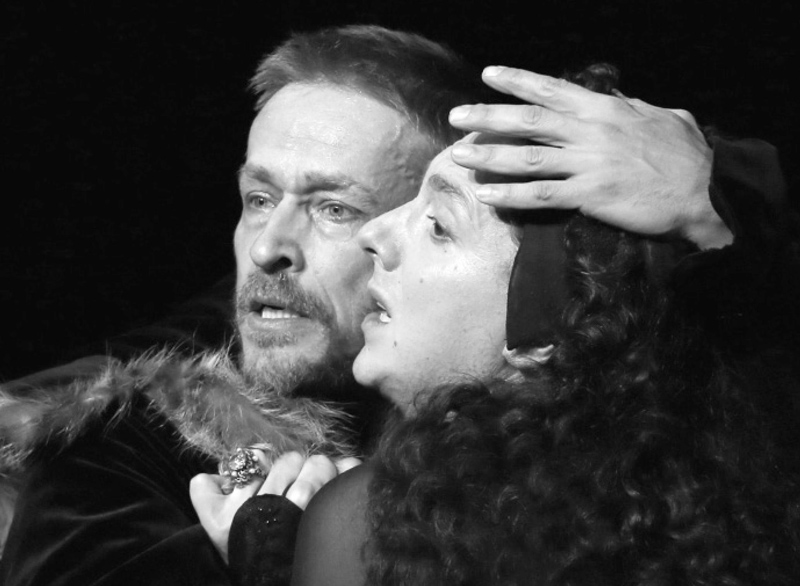
Eric Ruf in Lucrèce Borgia.
Photo credit: Laurencine Lot.
You don’t feel a rapport with these new actors?
Great actors engender great photos. To photograph great actors is really to be in communion with them.
Is it as if you are united with them? The camera seems to be capturing what is going on in them beneath the skin?
In my latest theatre book “Instants de théâtre” I think that’s the case. Photographing theatre is knowing how to capture what precisely will not last and which will never be seen in the same way again. I’ll never see those moments – those configurations of movement, voice, expression, emotion – ever again. Sometimes when I see a play a second time, I ask myself how it could have been possible I took the photos I did the day before. Because other things are happening on the stage. It is the same creation, the same play and production, but it is always in permanent renewal. It means that the theatre photographer is definitely inside a moment, and that moment never repeats itself. I mean, it is never expressed the same way ever again.
So, knowing this – does it give you a sense of power?
Oh not at all, certainly not power. I’m not a power woman.
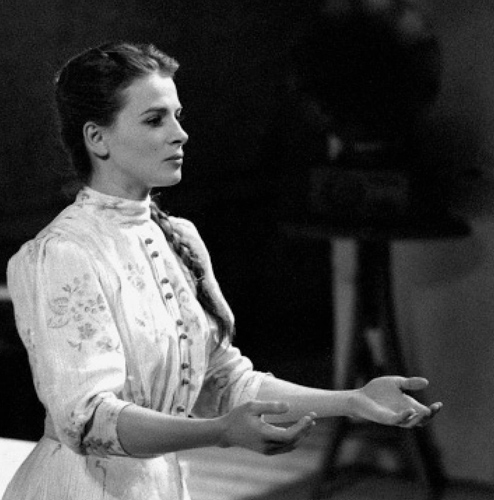
Juliette Binoche in La Mouette.
Photo credit: Laurencine Lot.
Or of omnipotence? Does it feel like you’re relating to eternity? You have created something permanent from what is fluid – how does that make you feel?
Yes, there is a sense of being up against eternity; I guess you could say it like that. It’s extracting the best possible out of the actor’s best possible performance on stage.
And I imagine that, when the actor is good and you are really into the flow of the play, you know precisely when to take your shot?
Yes, over the years it has become instinctive. But then again, I worked instinctively from the very beginning. In fact, when I photographed my favourite performer of all time, the Japanese Butoh dancer Carlotta Ikeda, she said that my camera and presence didn’t bother her at all because I always snapped the picture at precisely the end of a series of movements, at the point of closure. I had intuited the rhythms of her performance. [The book of Laurencine Lot’s images that is the result of these performance photo sessions is entitled “Carlotta Ikeda: Danse Butô et au-delà “with comments by Jean-Marc Adolphe, Lausanne: éditions Favre, 2005].
Can the professional theatre photographer just starting out today in France achieve the quality of work you have achieved? Do the young ones have a chance of making a living?
To be solely a theatre photographer is not possible any longer in France. I started in 1982, my studio at rue Condorcet in the ninth arrondissement is filled with computers now, but back in the 1980s I used film. I started on a journey that progressed from Leica to Canon. Those days are over. I don’t know how it is in other countries, but in Paris it is complicated to understand how the theatres operate. There are the private theatres, there are the private theatres that weren’t able to stay afloat on their own and which have been bought up by for-profit financial concerns, and there are the public theatres. The theatre photographer can’t hope to be asked to work professionally in all of these diverse kinds of theatres because we have more than sixty million photographers nowadays in France.
Sixty million?
With a mobile in hand, everyone is a photographer. So I’ve seen the scenographer photograph with his iPhone, or maybe it is the costume designer – click, click with her mobile phone. That isn’t being a theatre photographer, but it’s all the same to the people in the managerial and press department positions. They don’t much care about theatre photography. The attitude is, “Television is a lot more interesting”.
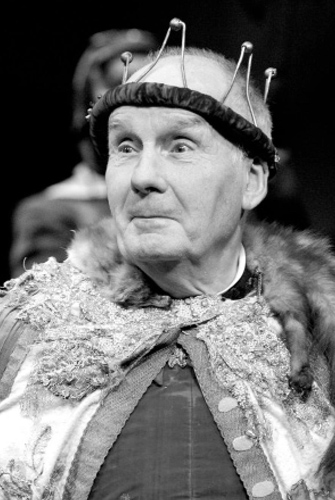
Michel Bouquet in Le Roi se meurt.
Photo credit: Laurencine Lot.
We are having the same problem at “Plays International & Europe”. We are seeing press photos that are increasingly selected for how well they will show up on somebody’s tiny phone screen. There is much less information in any one photograph like that than there used to be …
Precisely. There is a plethora of absolutely worthless industrial images out there now. Everything is worthless about them: the face of the actor, the costumes. The photo is worth absolutely nothing, and nobody knows any more what it means to photograph an actor or an actress or a comedian. The consequence of all that is devastating for me, and I’ve already been around for decades. I have friends and networks that keep me going even if generally nobody is interested in photos that have been crafted, developed.
Let’s compare today with how it was in the 1980s and 1990s. Then, there were press officers who were responsible for promoting the production and getting the word out about it. On press night, there could easily be 40 photographers for a single play. Every single newspaper and magazine sent over a photographer. They weren’t all necessarily specialists in theatre photography; the following day they might well be sent to a football match, but the result was that we were a large mass. Among them, there was a small nucleus of real theatre photographers who did nothing else professionally. Nowadays when I turn up on press night, either I am the only photographer there or we are less than ten – Le Figaro, Le Monde … those printed publications that still use theatre photography. They are becoming rare.

Hugues Quester and Valérie Dashwood.
Photo credit: Laurencine Lot.
Do you photograph for any of these publications?
No, I am totally independent. I’m invited to the press night. Beyond that, most of the time I do not even know ahead of time if I will be able to sell the photos I’ve taken. Nowadays, most private theatres don’t contract photographers. Out of habit, many theatres use my work generally. For instance, near to where I live you’ll find the Théâtre La Bruyère. I work there regularly and cover all the performances they put on. There I know they’ll buy the photos I offer them. I have the same relationship with several theatres. But there are a lot of photo séances where I am absolutely unsure as to whether the photos will be bought, if they will be considered useful or not. That’s just part and parcel of the profession these days.
And how does that work? You telephone “Le Monde” and you let them know you have photos of a particular new show?
No. It goes through the theatre; they give my name. I had a spot of good luck recently. Photos of mine got a half-page in “Le Figaro” twice. What was common in the 1990s looks like a miracle today!
Are you still able to live off your photography work?
It is becoming difficult. In my case, because I’ve been working since the 1980s, I have very large archives – enough for me to make or be asked to make books. The photos of Maria Casarès that I have go back to 1977. I have an entire repertoire of especially classical plays, and from time to time but regularly my photos are requested for school books. Recently, one of my photos was on the cover of Molière’s “The Bourgeois Gentleman” for a publishing house in Germany.

Maria Casares in La Mante polaire.
Photo credit: Laurencine Lot.
And that pays well?
I have the copyright.
The more copies are sold, the more you earn?
Oh no, you make me laugh. I got one payment for the right to use my photo.
I guess I can safely say then that the profession of theatre photographer is disappearing in France.
Not disappearing but much less appreciated. We are no longer in the epoch of Jean Vilar in Avignon with Agnès Varda taking photos of Vilar and his entourage. It’s tougher now. If a young French photographer were to ask me, I’d say don’t specialize in theatre photography. With my friends and connections, I would say it’s different for me. For example, I’ve taken the photos for three shows in Avignon without even having to go there. I photographed the rehearsals here in Paris or nearby. But I can tell you I wouldn’t like to be starting on this career right now.
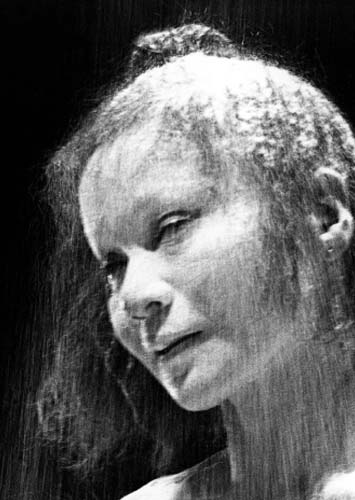
Carlotta Ikeda in Utt.
Photo credit: Laurencine Lot.
Do you know other theatre photographers?
Of course, I know the others in the trade. A few are independent, as I am, but usually they are in the hire of press agencies and are likely to be called upon to do other reports – the Cannes Film Festival for example or official openings. You have to be less specialized now; that’s all there is to it.
How did you become a theatre photographer?
When I graduated from high school in 1968, having passed my baccalaureate, my parents suggested that I learn German. I went to the Goethe Institute near Stuttgart and studied English in Paris as well. For a while I worked as a translator of scientific articles for the radio. My father was a science author who wrote about scientific advancements for the radio in Paris, so I was easily able to access that world. This gradually came to an end after my mother invited me to the Théâtre de la Porte Saint Martin to see “Godspell” for my birthday. When the performance ended, my mother – who was a philosopher, in fact one of her books had received a prize from the French Academy [“René Descartes” by Germaine Lot, 1967] – was extremely enthusiastic. She said she wanted to write a book about this musical. But she couldn’t find an interested publisher anywhere.
Had she asked you to take photos for the book?
No, it was she herself who started taking photos. She told my father, “If I can’t get anyone interested in my book, I can at least photograph the performance”. My father was taken aback, “How can you do that? It’s not possible!” She told him she was going to make a darkroom and a studio in the bathroom, and it was going to be me who would develop the photographs as she had a great fear of being in the dark. My father adored her, so he let her set it all up. Her photographs were excellent, but she never brought her craft up to a professional level. I became my mom’s messenger and gave away her photos to the actors. On the weekends when I wasn’t translating, I’d go over to the theatre; I was permitted free entry. I saw the production and became the troupe’s messenger as well. I’d go out and buy them Kleenex, and if they needed anything else I’d go get it. If one of them had a headache, I’d go buy aspirin. That was at the Théâtre de la Porte Saint Martin in 1972. I had my own loge and could come and go as I wanted. Daniel Auteuil was in the cast. I kept in contact with him, and that was one of the connections that helped me later on. I photographed only a bit, and that towards the end.

Amphitryon by Moliere.
Photo credit: Laurencine Lot.
In Britain, photos are never taken during the actual performances.
Nor here in France. We take the press photos during the final dress rehearsal.
Then your photographing “Godspell” whenever you felt like it was an exception?
Well, I was very discreet. When I photographed Carlotta for the first time, it was also during a public performance. She never had photo sessions. The management just said that Laurencine could come in, and I stood on a step in the auditorium, and nobody heard me.
Because your camera was silent?
I was using a Leica R4 at the time. It isn’t as silent as all that!
So, let’s hear more about your development professionally.
When the Théâtre national de la Colline opened in 1988 with Jorge Lavelli as artistic director, I had a renewable annual contract. It went on for ten years, ceasing only when Lavelli left that theatre. Then I had a contract at the Comédie-Française. That went on for about ten more years, and books came out of it too. [“La Comédie-Française: 30 ans de création théâtrale” by Laurencine Lot, text by Joël Huthwohl, in 2003 and “50 ans à la Comédie-Française: Catherine Samie, une enfant de Molière” in 2007].
And since then?
Tacit agreements. I’ve had regular work at the Théâtre Hébertot, Théâtre La Bruyère, Théâtre 14, Théâtre de la Huchette, and many more. And then I’ve become the photographer for certain companies too. The companies change their location, and I follow them. It can be the theatre that hires me, but also a stage director or one of the administrative directors in the theatre or a press service. Whoever it is who decides to ask for me specifically.
I’d like to move on to another topic. You’ve helped out “Plays International & Europe” by giving us photographs you took of “La Musica” by Marguerite Duras directed by Anatoly Vassiliev; the article which dates from 2016 was written by his dramaturge Natalia Isaeva. Can you tell us a bit about your relationship with Vassiliev as his Parisian photographer?
My first contact with Anatoly Vassiliev was when he directed Molière’s “Amphitryon” at the Comédie-Française, Salle Richelieu, in 2002. I am always amazed and totally fascinated by his work, what he puts on stage. To him, the stage is a sacred place. He forgets totally about time; his actors go through this same process of total dedication. Anatoly manages to develop the actors to a transcendent level. They surpass themselves.
What does Vassiliev do to get his actors to achieve more than they ever have before?
I don’t really know how he works, but there are weeks of training involved – physical training, vocal training. He has a very special method … I think you might find the answer in the book by Valérie Dréville for which I provided the photographs: “Face à Médée: Journal de repetition” (Paris: Actes Sud – Papiers, 2018). It is her diary of rehearsals working under Anatoly Vassiliev for their production of “Médée-Matériau” [a production adapted from the eponymous text by Heiner Müller, ed.]. It is likely to explain a lot better than I can what the actors are experiencing when they are being directed by Anatoly Vassiliev.
Can you tell me a little about your other books, the ones that don’t deal with the theatre?
Yes, sure. My husband Jean Verdun [French writer and playwright], who grew up in Aix, challenged me to photograph the mountain beloved by Cézanne in Aix-en-Provence, Mont Sainte-Victoire, in all its difficult moods. He wrote the accompanying text, and Anatoly Vassiliev wrote the introduction. [The book was published in 2009 by Édition Aubéron in France and is entitled “Sainte-Victoire: Magique montagne”.]
It is a mountain that changes colour all the time. From grey to ochre and all the shades in between. Yes, in the copy I am looking at I see blue and red, yellow and green. And the publisher got the colours exactly spot-on! Even winter: I’ve photographed the winter scenes with their translucidity using a particular kind of black and white film that no longer exists.
When I was working on this book, I told my friends that I was photographing a great actress. They said who is it, and I told them it was a mountain!
And what are you working on now?
Right now, in fact in October 2018, my book “Les Vélos du Monde” (“Bicycles of the World”) comes out [Paris: Tohubohu Éditions, 2018]. Ever since high school I’ve biked all over Paris, particularly at night from one theatre to another with my cameras on the back carrier rack. For the book, I travelled over the world photographing bicycles.
Did you use the same cameras that you use for your theatre photography?
Yes, there are some photos with my Leica R7 and some with my Canon EOS 5D. Also, I took what is practically my favourite photo in the book with my iPhone!
Who is your favourite theatre photographer?
Agnès Varda but she abandoned theatre after her time with Vilar and became a filmmaker.
I’d like to end this interview by asking you to tell us about your philosophy of theatre photography.
My philosophy? … I am extremely happy to have this profession. I can’t go to the theatre without thinking of photographing the show. To watch a show without my camera bores me. It is as if I am writing with images, my photos. I always think about photo shots when I watch a play. I see the personality of the actor in front of me – that is all I see … nothing about me is there; it’s all about the other. My photos become testimonials, the expression of a personal vision.
Translated from French by Dana Rufolo

